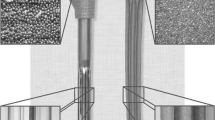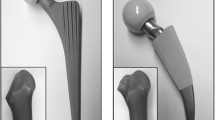Abstract
Introduction
The number of revision hip arthroplasties being performed is growing and implantation of a cementless stem has become established as the gold standard. For producing a primary stability, the press-fit procedure is the method of choice, but also can be achieved by multiple-point impactions. Specific femoral stems should follow the anatomical shape and provide a more extensive anchorage. The objective of this study was to evaluate the type, localization of the impaction and resulting primary stability of two different femoral revision stem designs (kinked vs. straight) after implantation via an endofemoral approach in the case of more extensive defects of the proximal femur.
Materials and methods
Cementless stems of two different designs were implanted in synthetic femurs. The specimens were analyzed by CT and tested considering axial/torsional stiffness and migration resistance in a servohydraulic testing machine.
Results
The present data do not show any significant differences between the two endofemorally implanted conical stems in contact area or in biomechanics with regard to migration and axial or torsional stiffness, despite having different designs.
Conclusions
The location, type and length of the stem anchorage are not only influenced by the kinked or straight design, but in particular also by the surgical approach. Also in the case of an extensive proximal bone defect, in the endofemoral approach, both a conical and a three-point anchorage occur. Here, the length of the conical anchorage determines the primary stability and should be at least 55 mm.







Similar content being viewed by others
References
Abendschein W (2003) Periprosthetic femur fractures—a growing epidemic. Am J Orthop 32(9 Suppl):34–36
Lindahl H (2007) Epidemiology of periprosthetic femur fracture around a total hip arthroplasty. Injury 38(6):651–654. https://doi.org/10.1016/j.injury.2007.02.048
Wähnert D, Schröder R, Schulze M et al (2014) Biomechanical comparison of two angular stable plate constructions for periprosthetic femur fracture fixation. Int Orthop 38(1):47–53. https://doi.org/10.1007/s00264-013-2113-0
Morrey BF, Kavanagh BF (1992) Complications with revision of the femoral component of total hip arthroplasty. Comparison between cemented and uncemented techniques. J Arthroplast 7(1):71–79
Lewallen DG, Berry DJ (1998) Periprosthetic fracture of the femur after total hip arthroplasty: treatment and results to date. Instr Course Lect 47:243–249
Kavanagh BF (1992) Femoral fractures associated with total hip arthroplasty. Orthop Clin North Am 23(2):249–257
Skutek M, Bourne RB, Mac Donald SJ (2006) International epidemiology of revision THR. Curr Orthop 20:157–161
Faschingbauer M, Kessler S, HJürgens C (2014) Periprosthetic fractures in enclosed total hip arthroplasty. Trauma Berufskrankh 16(4):349–353
Wirtz DC, Niethard FU (1997) Etiology, diagnosis and therapy of aseptic hip prosthesis loosening—a status assessment (Ursachen, Diagnostik und Therapie der aseptischen Huftendoprothesenlockerung–eine Standortbestimmung). Z Orthop Ihre Grenzgeb 135(4):270–280. https://doi.org/10.1055/s-2008-1039388
Paprosky WG, Greidanus NV, Antoniou J (1999) Minimum 10-year-results of extensively porous-coated stems in revision hip arthroplasty. Clin Orthop Relat Res 369:230–242
Pilliar RM, Lee JM, Maniatopoulos C (1986) Observations on the effect of movement on bone ingrowth into porous-surfaced implants. Clin Orthop Relat Res 208:108–113
Engh CA, O’Connor D, Jasty M et al (1992) Quantification of implant micromotion, strain shielding, and bone resorption with porous-coated anatomic medullary locking femoral prostheses. Clin Orthop Relat Res 285:13–29
Diehl P, Haenle M, Bergschmidt P et al (2010) Zementfreie Hüftendoprothetik: eine aktuelle Übersicht/Cementless total hip arthroplasty: a review (Cementless total hip arthroplasty: a review). Biomed Tech (Berl) 55(5):251–264. https://doi.org/10.1515/BMT.2010.037
Mai KT, Verioti CA, Casey K et al (2010) Cementless femoral fixation in total hip arthroplasty. Am J Orthop 39(3):126–130
Fink B, Fuerst M, Hahn M et al (2005) Principles of fixation of the cementless modular revision stem Revitan (Fixationsprinzipien des zementlosen modularen Huftrevisionsschaftes Revitan. Eine anatomische Studie). Unfallchirurg 108(12):1029–1032. https://doi.org/10.1007/s00113-005-0990-4 (1034–1037)
Sieber HP, Le Bèguec P (2001) Einsatz des PFM-R-Schaftes bei Revisionseingriffen. In: Perka C, Zippel H (eds) Revisionsendoprothetik des Hüftgelenkes. Schaftrekonstruktion und perioperatives management. Einhorn, Reinbeck, pp 174–184
Fink B, Grossmann A, Schubring S et al (2007) A modified transfemoral approach using modular cementless revision stems. Clin Orthop Relat Res 462:105–114. https://doi.org/10.1097/BLO.0b013e3180986170
Wirtz DC, Heller KD, Holzwarth U et al (2000) A modular femoral implant for uncemented stem revision in THR. Int Orthop 24(3):134–138
Rodriguez JA, Fada R, Murphy SB et al (2009) Two-year to five-year follow-up of femoral defects in femoral revision treated with the link MP modular stem. J Arthroplast 24(5):751–758. https://doi.org/10.1016/j.arth.2008.09.011
Meneghini RM, Hallab NJ, Berger RA et al. (2006) Stem diameter and rotational stability in revision total hip arthroplasty: a biomechanical analysis. J Orthop Surg Res 1:5. https://doi.org/10.1186/1749-799X-1-5
Bougherara H, Zdero R, Shah S et al (2010) A biomechanical assessment of modular and monoblock revision hip implants using FE analysis and strain gage measurements. J Orthop Surg Res 5:34. https://doi.org/10.1186/1749-799X-5-34
Zdero R, Walker R, Waddell JP et al (2008) Biomechanical evaluation of periprosthetic femoral fracture fixation. J B Jt Surg Am 90(5):1068–1077. https://doi.org/10.2106/JBJS.F.01561
Heiner AD (2008) Structural properties of fourth-generation composite femurs and tibias. J Biomech 41(15):3282–3284. https://doi.org/10.1016/j.jbiomech.2008.08.013
Wagner H, Wagner M (1993) Femur revision prosthesis (Femur-Revisionsprothese). Z Orthop Ihre Grenzgeb 131(6):574–577. https://doi.org/10.1055/s-2008-1040074
Engh CA, Bobyn JD, Glassman AH (1987) Porous-coated hip replacement. The factors governing bone ingrowth, stress shielding, and clinical results. J B Jt Surg Br 69(1):45–55
Lester DK, Campbell P, Ehya A et al (1998) Assessment of press-fit hip femoral components retrieved at autopsy. Orthopedics 21(1):27–33
Author information
Authors and Affiliations
Corresponding author
Ethics declarations
Funding
None.
Conflict of interest
The authors declare that they have no conflict of interest.
Rights and permissions
About this article
Cite this article
Heinecke, M., Rathje, F., Layher, F. et al. Anchoring and resulting primary stability of a kinked compared to a straight uncemented femoral stem. Arch Orthop Trauma Surg 138, 115–121 (2018). https://doi.org/10.1007/s00402-017-2833-5
Received:
Published:
Issue Date:
DOI: https://doi.org/10.1007/s00402-017-2833-5




